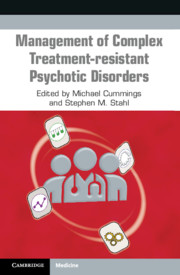Book contents
- Management of Complex Treatment-Resistant Psychotic Disorders
- Management of Complex Treatment-Resistant Psychotic Disorders
- Copyright page
- Contents
- Contributors
- Acknowledgements
- Abbreviations
- List of Icons
- Introduction
- Part I Treatment Strategies
- 1.01 Approaches to Positive Psychotic Symptoms
- 1.02 Use of Plasma Levels in Antipsychotic and Mood Stabilizer Treatment
- 1.03 Advantages of Long-Acting Injectable Antipsychotics
- 1.04 Approach to Treatment-Resistant Schizophrenia Spectrum Patients
- 1.05 Approach to Depressed or Suicidal Schizophrenia Spectrum Patients
- 1.06 Approach to Persistent Aggression and Violence in Schizophrenia Spectrum Psychotic Disorders
- 1.07 Approach to Bipolar Diathesis in Schizophrenia Spectrum Patients
- 1.08 Approach to Anxiety in Schizophrenia Spectrum Patients
- 1.09 Approach to Insomnia and Sleep Disturbance in Schizophrenia Spectrum Disorders
- 1.10 Approach to Psychosis in Children and Adolescents
- 1.11 Electroconvulsive Therapy and Other Non-Pharmacological Treatments
- 1.12 Approach to Substance Use Disorders in Schizophrenia Spectrum Disorders
- 1.13 Approaches to Behavioral Disturbances in Dementia and Traumatic Brain Injury Patients
- Part II Medication Reference Tables
- Appendices
- Index
- References
1.09 - Approach to Insomnia and Sleep Disturbance in Schizophrenia Spectrum Disorders
from Part I - Treatment Strategies
Published online by Cambridge University Press: 19 October 2021
- Management of Complex Treatment-Resistant Psychotic Disorders
- Management of Complex Treatment-Resistant Psychotic Disorders
- Copyright page
- Contents
- Contributors
- Acknowledgements
- Abbreviations
- List of Icons
- Introduction
- Part I Treatment Strategies
- 1.01 Approaches to Positive Psychotic Symptoms
- 1.02 Use of Plasma Levels in Antipsychotic and Mood Stabilizer Treatment
- 1.03 Advantages of Long-Acting Injectable Antipsychotics
- 1.04 Approach to Treatment-Resistant Schizophrenia Spectrum Patients
- 1.05 Approach to Depressed or Suicidal Schizophrenia Spectrum Patients
- 1.06 Approach to Persistent Aggression and Violence in Schizophrenia Spectrum Psychotic Disorders
- 1.07 Approach to Bipolar Diathesis in Schizophrenia Spectrum Patients
- 1.08 Approach to Anxiety in Schizophrenia Spectrum Patients
- 1.09 Approach to Insomnia and Sleep Disturbance in Schizophrenia Spectrum Disorders
- 1.10 Approach to Psychosis in Children and Adolescents
- 1.11 Electroconvulsive Therapy and Other Non-Pharmacological Treatments
- 1.12 Approach to Substance Use Disorders in Schizophrenia Spectrum Disorders
- 1.13 Approaches to Behavioral Disturbances in Dementia and Traumatic Brain Injury Patients
- Part II Medication Reference Tables
- Appendices
- Index
- References
Summary
Nature is replete with cyclic biological rhythms ranging in periodicity from much less than a day (ultradian) to months or years (infradian) [1]. For humans, however, biological rhythms that are about 24 hours in duration (circadian) are critical to healthy functioning. Among the most important of these is the sleep-wake cycle [2]. A recent review, meta-analysis, and moderator analysis of 31 polysomnographic studies (n=574) conducted between 1968 and 2014 found that patients suffering from schizophrenia spectrum disorders have significantly shorter total sleep time, longer sleep onset latency, more wake time after sleep onset, lower sleep efficiency, and decreased stage 4 sleep, slow wave sleep, and duration and latency of rapid eye movement sleep compared to healthy controls. The findings regarding delta waves and sleep spindles were inconsistent. Moderator analysis could not find any abnormalities in sleep architecture [3]. Among healthy sleep-deprived individuals subclinical psychotic experiences are increased. While data are less clear, insomnia also may increase psychotic signs and symptoms among schizophrenic patients, suggesting a possible bidirectional pathologic effect [4]. In particular, patients vulnerable to a bipolar diathesis may have their clinical stability decompensated and driven by insomnia [5]. Thus, maintenance of adequate sleep may be a critical element in the treatment of some patients with schizophrenia spectrum disorders.
- Type
- Chapter
- Information
- Publisher: Cambridge University PressPrint publication year: 2021



